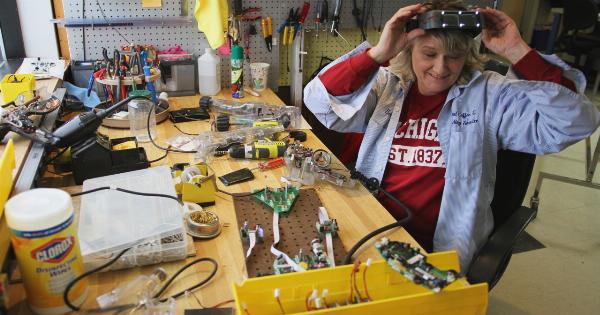Living with visual impairment can be challenging, affecting every aspect of a person’s life. However, advancements in technology have paved the way for innovative solutions that are transforming the lives of the visually impaired.
One such groundbreaking development is the introduction of eyewear that helps illuminate their world, offering enhanced vision and newfound independence. This article explores the various types of innovative eyewear available and how they are positively impacting the lives of those with visual impairments.
1. Smart Glasses: A Visionary Solution
Smart glasses are a significant leap forward in assistive eyewear technology. These glasses utilize advanced algorithms and cutting-edge sensors to capture visual information and convert it into accessible formats.
The data is then displayed on a high-definition screen located in front of the wearer’s eye, enabling them to perceive their surroundings more clearly.
2. Augmented Reality Glasses: A Digital Overlay
Augmented reality (AR) glasses are another remarkable innovation that is making a profound difference for the visually impaired.
These glasses superimpose real-time digital overlays onto the wearer’s field of vision, enhancing their understanding of the environment. For example, when navigating unfamiliar surroundings, the AR glasses can provide audio cues, step-by-step directions, or descriptions of nearby objects, greatly improving spatial awareness and facilitating independent mobility.
3. Electronic Magnifying Glasses: A Clearer View
Electronic magnifying glasses are designed to assist individuals with low vision. These glasses use powerful magnification technology combined with high-resolution displays to provide a clearer and enlarged view of objects.
Users can adjust the magnification level according to their specific needs, allowing them to read texts, recognize faces, or engage in hobbies with greater ease and enjoyment.
4. Night Vision Eyewear: Illuminating Darkness
The visually impaired face unique challenges when navigating in low-light conditions or at night. Night vision eyewear has been developed specifically to address this issue.
These electronic glasses employ infrared sensors to capture and process the surrounding thermal radiation, converting it into visible light that is then displayed on the user’s screen. With the assistance of night vision eyewear, individuals with visual impairments can confidently navigate their surroundings with enhanced night vision.
5. Tactile Glasses: Hands-On Experience
Tactile glasses provide individuals with visual impairments the opportunity to experience their surroundings through touch.
These glasses are equipped with an array of sensors that detect nearby objects and convert the visual information into vibrations. By interpreting these vibrations, users can navigate their environment, detect obstacles, and gain a better understanding of their surroundings without relying solely on auditory cues.
6. Smart Contact Lenses: A Futuristic Approach
While still in the early stages of development, smart contact lenses hold immense promise for the visually impaired.
These technologically advanced lenses incorporate microelectronics to create augmented reality experiences directly on the wearer’s eyes. By overlaying digital images onto their visual field, individuals with visual impairments can enhance their vision and gain a clearer understanding of their surroundings in real-time.
7. Head-Mounted Cameras: A New Perspective
Head-mounted cameras offer individuals with visual impairments an entirely new perspective on their surroundings.
These cameras capture live video footage and transmit it to a small screen located on the eyewear, allowing wearers to see through the camera’s lens. This technology not only enhances the wearer’s vision but also enables them to zoom in on specific objects, read signs, or recognize faces from a distance.
8. BlindSpot Glasses: Navigating Obstacles
BlindSpot glasses have been designed specifically to address the challenges of navigating through crowded or cluttered spaces. These glasses use sophisticated sensors and computer algorithms to detect obstacles in the wearer’s path.
When a potential hazard is detected, the glasses alert the user through a combination of audio and vibrational cues, allowing for safe, independent movement and reducing the risk of accidents.
9. Color-Enhancing Glasses: Vibrant Experiences
For individuals with color blindness, color-enhancing glasses offer a transformative experience by allowing them to perceive colors more accurately.
These glasses utilize specialized filters and optical technologies to modify the wavelengths of light reaching the wearer’s eyes, enhancing their ability to distinguish between different hues. With color-enhancing glasses, individuals with color blindness can fully appreciate and engage with the colorful world around them.
10. Fashionable Eyewear: Style With Functionality
Besides their technological advancements, innovative eyewear has come a long way in terms of design and aesthetics. Gone are the days of functional yet clunky assistive devices.
Today, visually impaired individuals can choose from a wide range of fashionable eyewear that seamlessly combines style and functionality. These eyewear options not only enhance their vision and independence but also allow them to express their personal style and feel confident in their appearance.
As the field of assistive technology continues to evolve, innovative eyewear is playing an instrumental role in improving the lives of the visually impaired.
With each breakthrough, individuals with visual impairments gain greater access to information, independence, and a more enriched understanding of the world around them. With such remarkable advancements, the future looks brighter than ever for those living with visual impairment.































